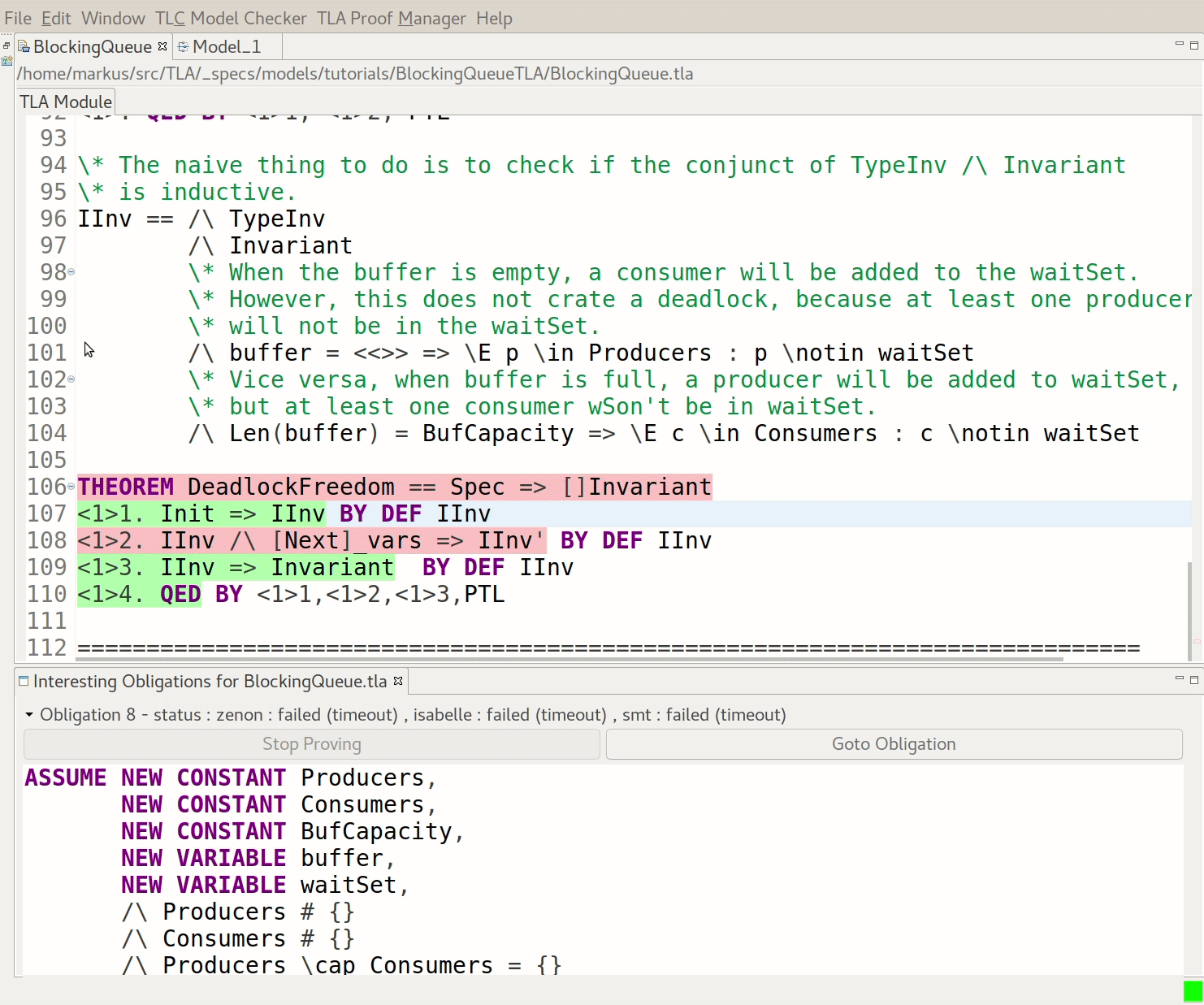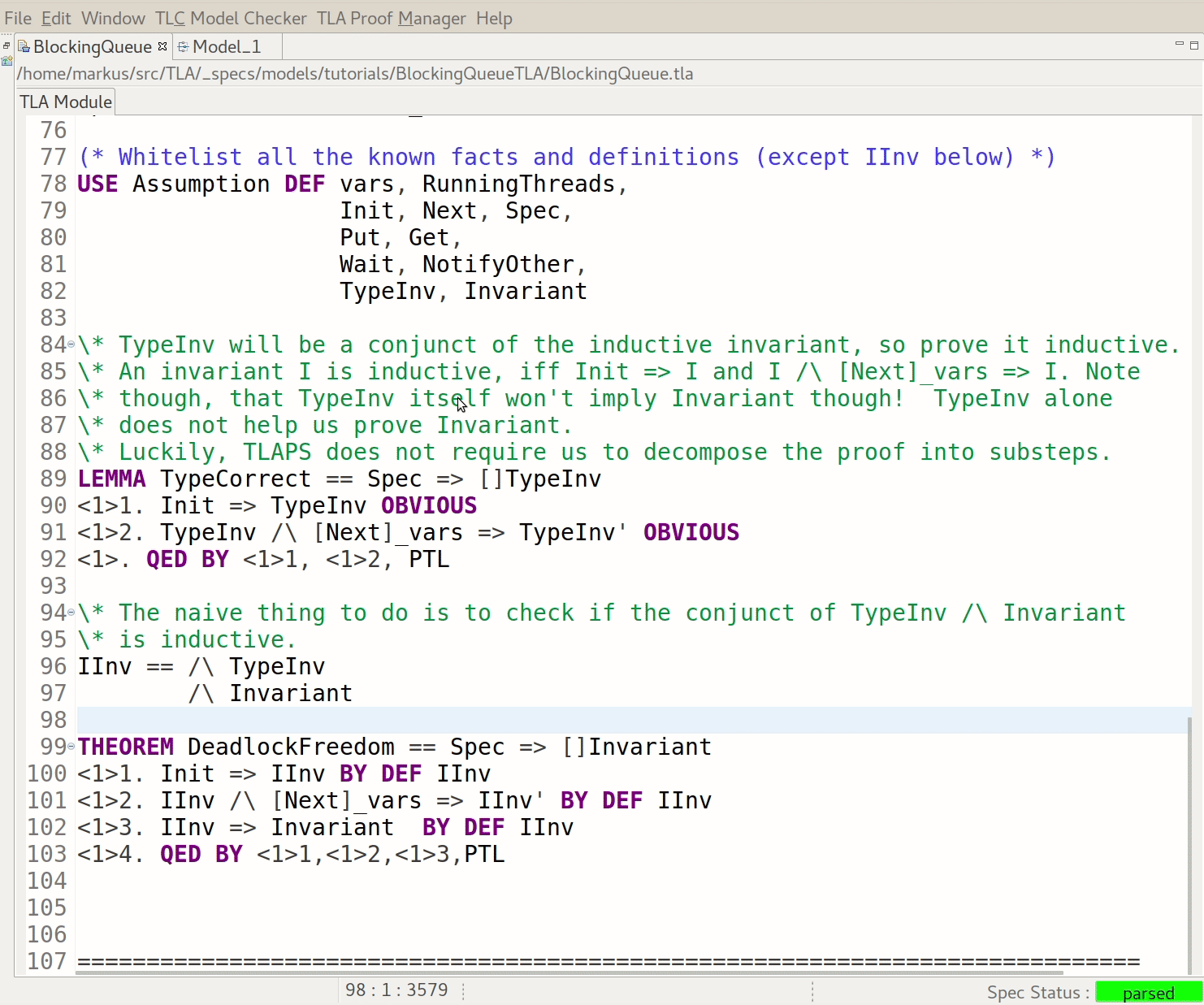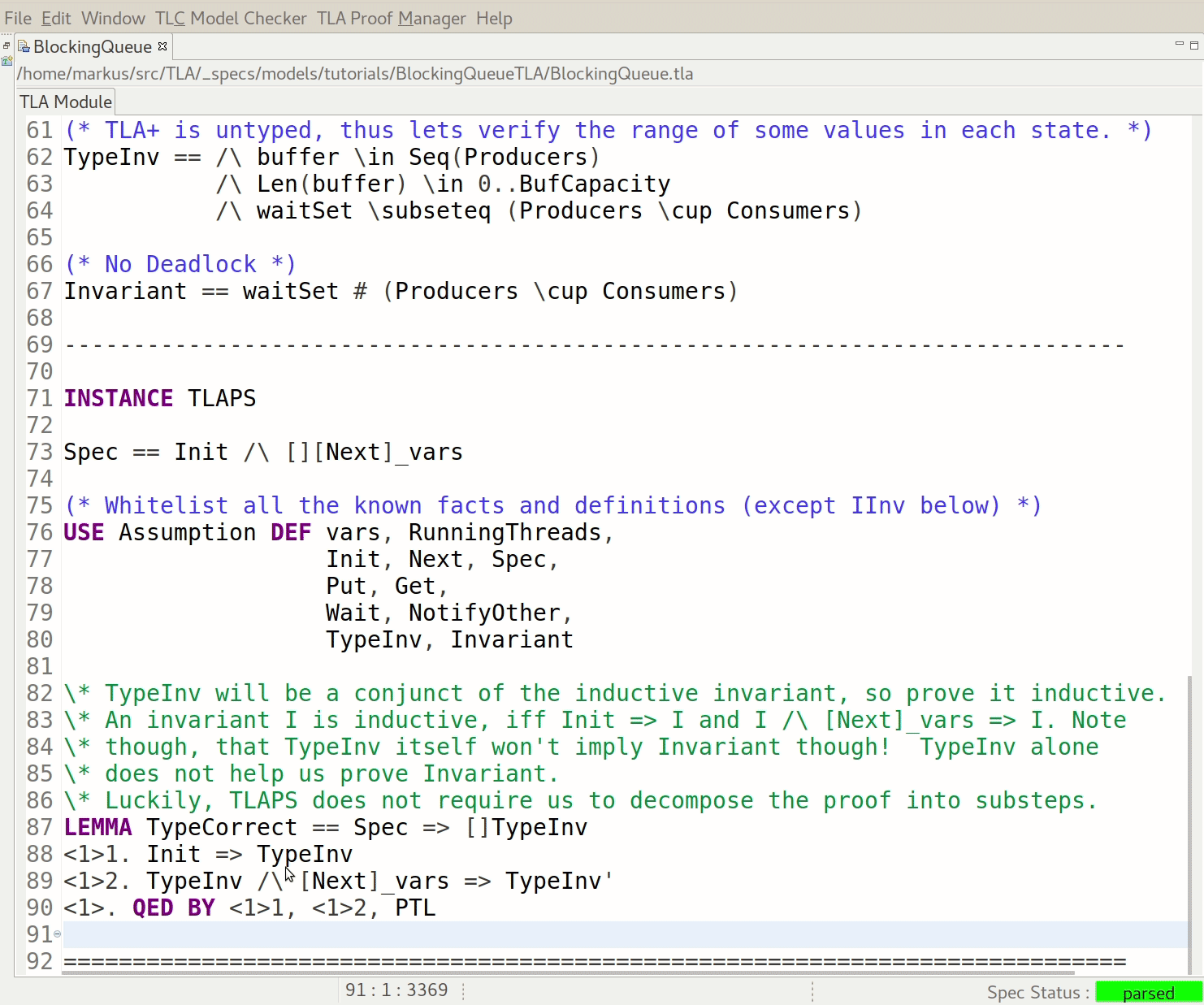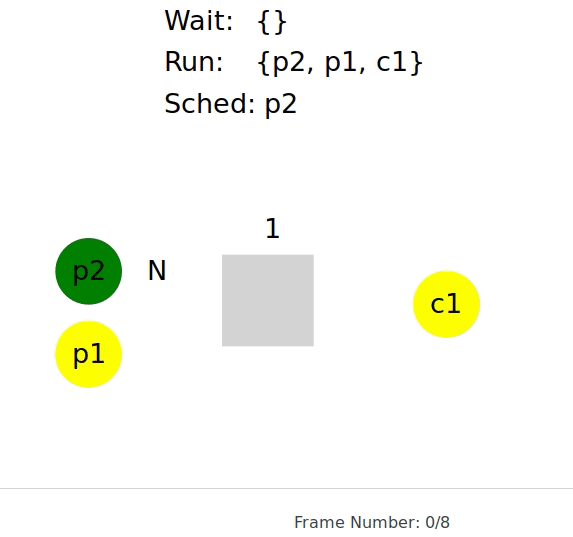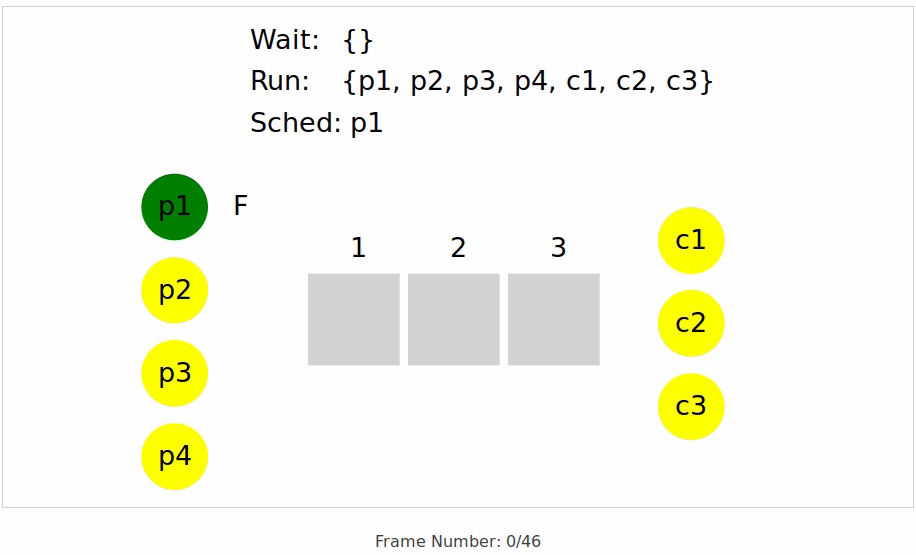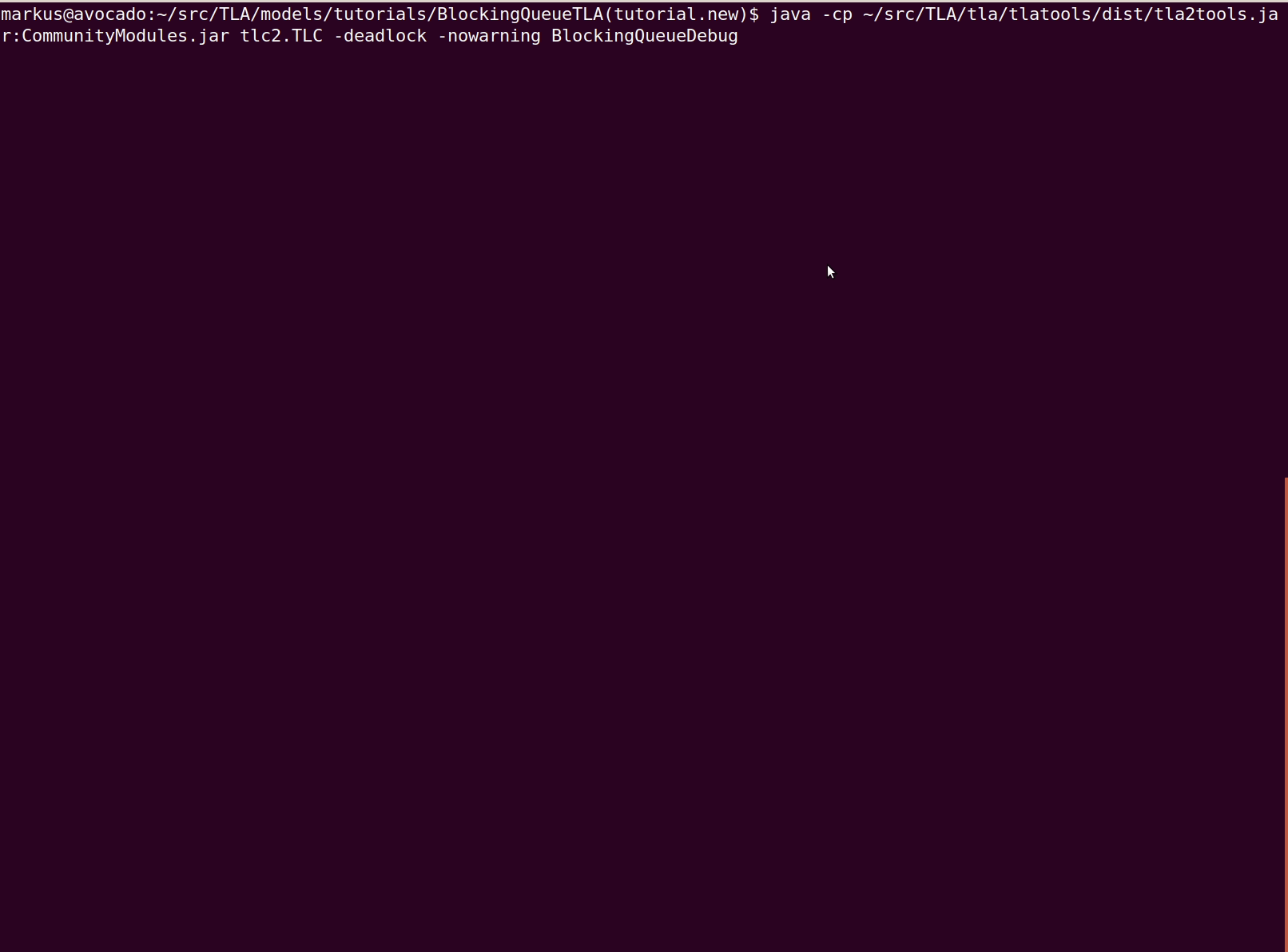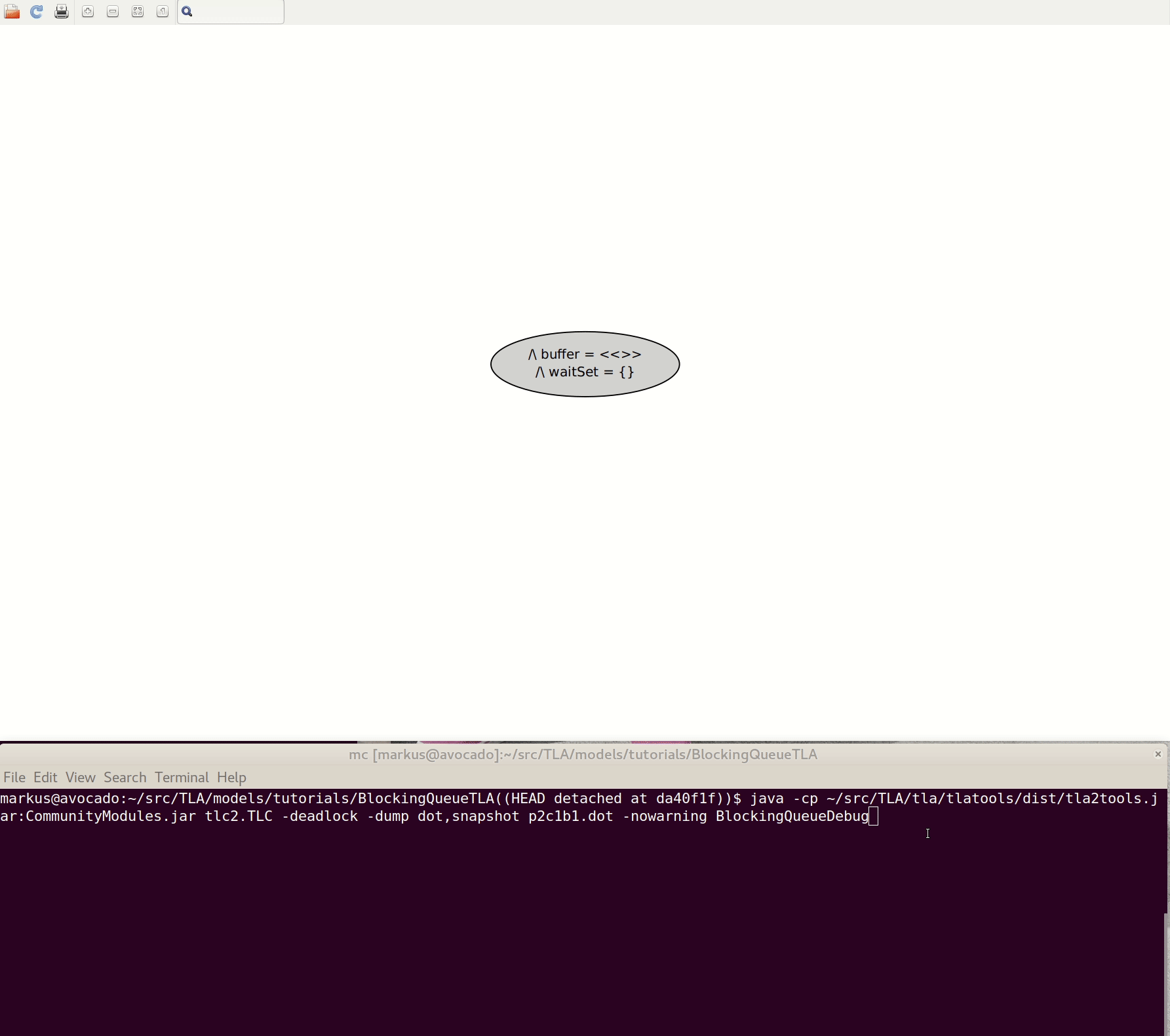lemmy / Blockingqueue
Programming Languages
Projects that are alternatives of or similar to Blockingqueue
BlockingQueue
Tutorial-style talk "Weeks of debugging can save you hours of TLA+". The inspiration for this tutorial and definitive background reading material (with spoilers) is "An Example of Debugging Java with a Model Checker " by Michel Charpentier. I believe it all goes back to Challenge 14 of the c2 wiki.
Each git commit introduces a new TLA+ concept. Go back to the very first commit to follow along! Please note - especially when you create PRs -that the git history will be rewritten frequently to stay linear.
Click either one of the buttons to launch a zero-install IDE to give the TLA+ specification language a try:
This tutorial is work in progress. More chapters will be added in the future. In the meantime, feel free to open issues with questions, clarifications, and recommendations. You can also reach out to me on twitter. Basic TLA+ learning material can be found over at Lamport's TLA+ page.
v31 (Refinement Fair): Prove BlockingQueueFair implements BlockingQueueSplit.
A proof showing that BlockingQueueSplit implements BlockingQueueSplit. Two lemmas show that it is sometimes necessary to prove simpler facts first to prove the main theorem.
Compared to the previous proofs, this one is far more involved and more realistically reflects the efforts require to write proofs; the refinement proof took approximately three weeks. Three weeks is quite an investment considering that the correctness of the refinement seems straight forward in the first place. However, three weeks also includes the work to detect and help with a fix for a regression in TLAPS 1.4.4, identifying two Toolbox issues, and familiarizing myself with the TLAPS build and development process.
v30 (Refinement Fair): Prove TypeInv is an inductive invariant of BlockingQueueFair.
As a first step of proving that BlockingQueueFair refines BlockingQueueSplit, we once again prove inductiveness of TypeInv.
v29 (Refinement Fair): Refine BlockingQueue with BlockingQueueFair spec.
BlockingQueueFair refines BlockingQueueSplit by notifying the longest-waiting producer or consumer thread instead of any thread in waitC or waitP. For that, it uses (ordered) sequences in place of the (unordered) sets. The refinement mapping is straight forward: BlockingQueueSplit!waitC and waitP are refined by the sequences waitSeqC and waitSeqP respectively. TLC checked the refinement mapping for the finite model with the configuration p4c3b3.
v28 (Starvation): Weak fairness defined for Put.
Defining Next to be (weakly) fair makes only sure that a Next-step is (eventually) taken. However, Next is a disjunct of the Put and Get sub-actions and fairness does not distribute. Since, we want all producers to eventually take steps, we specify (weak) fairness at the level of the Put sub-actions. Unfortunately, producers can still starve:
Checking temporal properties for the complete state space with 1600 total distinct states at (2020-01-18 15:28:06)
Error: Temporal properties were violated.
Error: The following behavior constitutes a counter-example:
State 1: <Initial predicate>
/\ buffer = <<>>
/\ waitSet = {}
State 2: <Next line 54, col 9 to line 57, col 45 of module BlockingQueue>
/\ buffer = <<p2>>
/\ waitSet = {}
State 3: <Next line 54, col 9 to line 57, col 45 of module BlockingQueue>
/\ buffer = <<p2, p3>>
/\ waitSet = {}
State 4: <Next line 54, col 9 to line 57, col 45 of module BlockingQueue>
/\ buffer = <<p2, p3, p2>>
/\ waitSet = {}
State 5: <Next line 54, col 9 to line 57, col 45 of module BlockingQueue>
/\ buffer = <<p2, p3, p2>>
/\ waitSet = {p1}
State 6: <Next line 54, col 9 to line 57, col 45 of module BlockingQueue>
/\ buffer = <<p2, p3, p2>>
/\ waitSet = {p1, p4}
State 7: <Next line 54, col 9 to line 57, col 45 of module BlockingQueue>
/\ buffer = <<p2, p3, p2>>
/\ waitSet = {p1, p2, p4}
State 8: <Next line 54, col 9 to line 57, col 45 of module BlockingQueue>
/\ buffer = <<p2, p3, p2>>
/\ waitSet = {p1, p2, p3, p4}
State 9: <Next line 54, col 9 to line 57, col 45 of module BlockingQueue>
/\ buffer = <<p3, p2>>
/\ waitSet = {p1, p2, p3}
State 10: <Next line 54, col 9 to line 57, col 45 of module BlockingQueue>
/\ buffer = <<p2>>
/\ waitSet = {p1, p2}
State 11: <Next line 54, col 9 to line 57, col 45 of module BlockingQueue>
/\ buffer = <<>>
/\ waitSet = {p1}
State 12: <Next line 54, col 9 to line 57, col 45 of module BlockingQueue>
/\ buffer = <<p2>>
/\ waitSet = {p1}
State 13: <Next line 54, col 9 to line 57, col 45 of module BlockingQueue>
/\ buffer = <<p2, p3>>
/\ waitSet = {p1}
Back to state 5: <Next line 54, col 9 to line 57, col 45 of module BlockingQueue>
Finished checking temporal properties in 00s at 2020-01-18 15:28:06
12313 states generated, 1600 distinct states found, 0 states left on queue.
v27 (Starvation): Starvation of individual producers.
Individual Producer or Consumer threads can starve because we haven't specified fair (except for weak fairness of Next to avoid the trivial counter-example of stuttering after Init).
This steps introduces the concept of liveness and fairness and how they are expressed in TLA+.
Checking temporal properties for the complete state space with 1600 total distinct states at (2020-01-17 16:04:37)
Error: Temporal properties were violated.
Error: The following behavior constitutes a counter-example:
State 1: <Initial predicate>
/\ buffer = <<>>
/\ waitSet = {}
State 2: <Next line 54, col 9 to line 57, col 45 of module BlockingQueue>
/\ buffer = <<>>
/\ waitSet = {c1}
State 3: <Next line 54, col 9 to line 57, col 45 of module BlockingQueue>
/\ buffer = <<p4>>
/\ waitSet = {}
Back to state 1: <Next line 54, col 9 to line 57, col 45 of module BlockingQueue>
v26 (Starvation): Refactor specification to move action enabling condition into Put and Get.
So far, the spec was written in a way that the Put and Get sub-actions of Next were permanently enabled, i.e. \A p \in Producers : ENABLED Put(p,p) was an invariant of Spec (vice versa for Consumers). The next-state relation \E t \in RunningThreads: t \in Producers /\ ... took care of scheduling "enabled" producers only. Here, we refactor the next-state relation and "push" the enabling condition into the sub-actions. With this change, \A p \in Producers : ENABLED Put(p,p) is no longer invariant (see trace below). Subsequent steps will show the reason why we refactored the spec. Note however, that this refactoring does not change the set of behaviors defined by Spec.
Invariant PutEnabled is violated.
The behavior up to this point is:
1: <Initial predicate>
/\ buffer = <<>>
/\ waitSet = {}
2: <Put line 34, col 1 to line 39, col 16 of module BlockingQueue>
/\ buffer = <<p1>>
/\ waitSet = {}
3: <Put line 34, col 1 to line 39, col 16 of module BlockingQueue>
/\ buffer = <<p1>>
/\ waitSet = {p1}
v25 (Refinement): Implement BlockingQueueSplit spec in Java and C.
Knowing that BlockingQueueSplit refines BlockingQueue and thus is deadlock-free, we shift our attention to the Java (and C) program. Instead of Java's synchronized statement, we implement BlockingQueueSplit with the help of the low-level synchronization primitive java.util.concurrent.locks.ReentrantLock and java.util.concurrent.locks.Condition. Executing the new program for a couple of hours with configuration p2c1b1 reveals no deadlock (the broken version of the program deadlocked within seconds). This, and the fact that Java's own ArrayBlockingQueue has a similar implementation, should silence our concerns to put the program into production.
v24 (Refinement): Prove refinement mapping of BlockingQueueSplit.
Below, TLC checked the refinement mapping for a finite model/particular configuration, which gives for BlockingQueueSplit sufficient confidence that the refinement mapping is correct. The fact that the refinement mapping is straight forward indicates that a TLAPS prove is likely straight forward too. So let's give in to the academic in us and prove the correctness of the refinement mapping. To prove that BlockingQueueSplit implements BlockingQueue, we first prove TypeInv inductive with the now know invariance proof rule. Once we have proven this LEMMA, we reuse it and the proof rule for refinement (section 4.2) to prove THEOREM Implements == Spec => A!Spec.
v23 (Refinement): Refine BlockingQueue with BlockingQueueSplit.
The specs BlockingQueueSplit.tla and BlockingQueue.tla look almost identical, except BlockingQueueSplit.tla has one more variable and slightly different definitions for Put, Get, Wait, and NotifyOther. However, there is no (logical) connection between the two specs, albeit spec BlockingQueueSplit can be considered an implementation of BlockingQueue.
This is where TLA's secret power comes into play. In an earlier step, we wrote THEOREM DeadlockFreedom == Spec => []Invariant to state that BlockingQueue satisfies []Invariant where []Invariant was a (safety) property. However, TLA does not distinguish between properties and (machine) specs; both are "just" formulas. This power means that we may also say that the spec defined in BlockingQueueSplit satisfies/implements the machine spec BlockingQueue by stating THEOREM Implements == Spec => BlockingQueue!Spec.
We are almost done. However, since BlockingQueueSplit differs slightly from BlockingQueue, we have to provide a refinement mapping that relates the low-level spec to the high-level spec. In the case of BlockingQueueSplit, it is fortunately straight forward: the union of waitC and waitP maps to waitSet.
We can verify the correctness of the refinement mapping (for a finite model) with TLC again. This time though, TLC does not check an invariant (state formula) but the (temporal) property BlockingQueue!Spec.
Sidenote: "TLA" above is not a typo! Read Lamport's The Temporal Logic of Actions to understand why.
v22 (Refinement): Create BlockingQueueSplit with two sets waitP and waitC.
The bugfix below exploited the power of (Zermelo-Fraenkel) set theory to get away without changing waitSet into two (disjoint) sets; one for waiting Producers and one for waiting Consumers (we will call them waitP and waitC respectively). In a real-world program, however, the elegance of math is likely too inefficient which is why a program would indeed maintain waitP and waitP to avoid intersecting Producers and Consumers from waitSet over and over again (which probably allocates temporary memory too). In an actual project, we would probably spend no more than a few minutes on analyzing if separating waitSet into waitP and waitC can introduce a deadlock again. Here, we have the luxury of time and thus write a new spec BlockingQueueSplit.tla. Fortunately, most of BlockingQueueSplit.tla is identical to BlockingQueue.tla which is why we copy&paste from BlockingQueue before we modify NotifyOther.
v21 (Traces): Validate long executions against the spec.
The previous step showed that trace validation is probabilistic and has no guarantees of finding violations of the high-level spec. Thus, we want to increase the chance by checking a long or many traces. However, copying long traces into the spec is not only a nuisance, but also slows down SANY. This step introduces how to serialize the app's output in a format that TLC can de-serialize efficiently with the help of the IOUtils module.
java -XX:StartFlightRecording=disk=true,dumponexit=true,filename=app-$(date +%s).jfr -cp impl/src/ org.kuppe.App
# Kill the process after a while.
# app-XXXXXXX.jfr is the flight recording created by the previous command.
# app-XXXXXXX.bin is the serialized app output.
java -cp tla2tools.jar:impl/src/ org.kuppe.App2TLA app-XXXXXXX.jfr app-$(date +%s).bin
With the longer trace (note the change in BlockingQueueTrace.tla), we are lucky and TLC finds a violation:
$ java -cp /opt/TLA+Toolbox/tla2tools.jar:CommunityModules.jar tlc2.TLC BlockingQueueTrace
TLC2 Version 2.15 of Day Month 20?? (rev: 52e91aa)
Warning: Please run the Java VM which executes TLC with a throughput optimized garbage collector by passing the "-XX:+UseParallelGC" property.
(Use the -nowarning option to disable this warning.)
Running breadth-first search Model-Checking with fp 10 and seed -2300318498630499187 with 1 worker on 4 cores with 5964MB heap and 64MB offheap memory [pid: 32602] (Linux 4.18.0-16-generic amd64, Azul Systems, Inc. 11.0.6 x86_64, MSBDiskFPSet, DiskStateQueue).
Parsing file /home/markus/src/TLA/_specs/models/tutorials/BlockingQueueTLA/BlockingQueueTrace.tla
Parsing file /tmp/TLC.tla
Parsing file /tmp/Sequences.tla
Parsing file /tmp/Naturals.tla
Parsing file /tmp/FiniteSets.tla
Parsing file /tmp/IOUtils.tla
Parsing file /home/markus/src/TLA/_specs/models/tutorials/BlockingQueueTLA/BlockingQueue.tla
Parsing file /home/markus/src/TLA/_specs/models/tutorials/BlockingQueueTLA/TLAPS.tla
Semantic processing of module Naturals
Semantic processing of module Sequences
Semantic processing of module FiniteSets
Semantic processing of module TLC
Semantic processing of module IOUtils
Semantic processing of module TLAPS
Semantic processing of module BlockingQueue
Semantic processing of module BlockingQueueTrace
Starting... (2020-01-25 20:32:19)
Failed to match TLCExt!AssertError operator override from jar:file:/home/markus/src/TLA/_specs/models/tutorials/BlockingQueueTLA/CommunityModules.jar!/tlc2/overrides/TLCExt.class with signature: <Java Method: public static synchronized tlc2.value.impl.Value tlc2.overrides.TLCExt.assertError(tlc2.tool.impl.Tool,tla2sany.semantic.ExprOrOpArgNode[],tlc2.util.Context,tlc2.tool.TLCState,tlc2.tool.TLCState,int,tlc2.tool.coverage.CostModel)> (no such module).
Failed to match TLCExt!PickSuccessor operator override from jar:file:/home/markus/src/TLA/_specs/models/tutorials/BlockingQueueTLA/CommunityModules.jar!/tlc2/overrides/TLCExt.class with signature: <Java Method: public static synchronized tlc2.value.impl.Value tlc2.overrides.TLCExt.pickSuccessor(tlc2.tool.impl.Tool,tla2sany.semantic.ExprOrOpArgNode[],tlc2.util.Context,tlc2.tool.TLCState,tlc2.tool.TLCState,int,tlc2.tool.coverage.CostModel)> (no such module).
Loading IODeserialize operator override from tlc2.overrides.IOUtils with signature: <Java Method: public static final tlc2.value.IValue tlc2.overrides.IOUtils.deserialize(tlc2.value.impl.StringValue,tlc2.value.impl.BoolValue) throws java.io.IOException>.
Loading IOSerialize operator override from tlc2.overrides.IOUtils with signature: <Java Method: public static final tlc2.value.IValue tlc2.overrides.IOUtils.serialize(tlc2.value.IValue,tlc2.value.impl.StringValue,tlc2.value.impl.BoolValue) throws java.io.IOException>.
Implied-temporal checking--satisfiability problem has 1 branches.
Computing initial states...
Finished computing initial states: 1 distinct state generated at 2020-01-25 20:32:19.
Error: Action property line 75, col 17 to line 75, col 29 of module BlockingQueue is violated.
Error: The behavior up to this point is:
State 1: <Initial predicate>
/\ buffer = <<>>
/\ i = 1
/\ waitSet = {}
State 2: <waitC line 149, col 10 to line 154, col 28 of module BlockingQueueTrace>
/\ buffer = <<>>
/\ i = 2
/\ waitSet = {"c1"}
State 3: <put line 156, col 8 to line 166, col 73 of module BlockingQueueTrace>
/\ buffer = <<"p1">>
/\ i = 3
/\ waitSet = {}
State 4: <put line 156, col 8 to line 166, col 73 of module BlockingQueueTrace>
/\ buffer = <<"p1", "p1">>
/\ i = 4
/\ waitSet = {}
State 5: <get line 168, col 8 to line 173, col 32 of module BlockingQueueTrace>
/\ buffer = <<"p1">>
/\ i = 5
/\ waitSet = {}
State 6: <put line 156, col 8 to line 166, col 73 of module BlockingQueueTrace>
/\ buffer = <<"p1", "p1">>
/\ i = 6
/\ waitSet = {}
State 7: <get line 168, col 8 to line 173, col 32 of module BlockingQueueTrace>
/\ buffer = <<"p1">>
/\ i = 7
/\ waitSet = {}
State 8: <put line 156, col 8 to line 166, col 73 of module BlockingQueueTrace>
/\ buffer = <<"p1", "p1">>
/\ i = 8
/\ waitSet = {}
State 9: <put line 156, col 8 to line 166, col 73 of module BlockingQueueTrace>
/\ buffer = <<"p1", "p1", "p1">>
/\ i = 9
/\ waitSet = {}
State 10: <waitP line 139, col 10 to line 147, col 28 of module BlockingQueueTrace>
/\ buffer = <<"p1", "p1", "p1">>
/\ i = 10
/\ waitSet = {"p1"}
State 11: <get line 168, col 8 to line 173, col 32 of module BlockingQueueTrace>
/\ buffer = <<"p1", "p1">>
/\ i = 11
/\ waitSet = {}
State 12: <put line 156, col 8 to line 166, col 73 of module BlockingQueueTrace>
/\ buffer = <<"p1", "p1", "p1">>
/\ i = 12
/\ waitSet = {}
State 13: <waitP line 139, col 10 to line 147, col 28 of module BlockingQueueTrace>
/\ buffer = <<"p1", "p1", "p1">>
/\ i = 13
/\ waitSet = {"p1"}
State 14: <waitP line 139, col 10 to line 147, col 28 of module BlockingQueueTrace>
/\ buffer = <<"p1", "p1", "p1">>
/\ i = 14
/\ waitSet = {"p1", "p2"}
State 15: <get line 168, col 8 to line 173, col 32 of module BlockingQueueTrace>
/\ buffer = <<"p1", "p1">>
/\ i = 15
/\ waitSet = {"p1"}
State 16: <put line 156, col 8 to line 166, col 73 of module BlockingQueueTrace>
/\ buffer = <<"p1", "p1", "p2">>
/\ i = 16
/\ waitSet = {}
2529 states generated, 1169 distinct states found, 63 states left on queue.
The depth of the complete state graph search is 16.
The average outdegree of the complete state graph is 1 (minimum is 0, the maximum 4 and the 95th percentile is 4).
Finished in 01s at (2020-01-25 20:32:20)
Convince yourself that TLC has indeed reported a violation of the high-level spec that is due to single-mutex bug. Do so by re-running TLC with the two-mutex fix temporarily reverted (TLC reports no error):
diff --git a/BlockingQueue.tla b/BlockingQueue.tla
index aba689d..d5d2e41 100644
--- a/BlockingQueue.tla
+++ b/BlockingQueue.tla
@@ -19,7 +19,7 @@ vars == <<buffer, waitSet>>
RunningThreads == (Producers \cup Consumers) \ waitSet
NotifyOther(t) ==
- LET S == IF t \in Producers THEN waitSet \ Producers ELSE waitSet \ Consumers
+ LET S == waitSet
IN IF S # {}
THEN \E x \in S : waitSet' = waitSet \ {x}
ELSE UNCHANGED waitSet
In a real project, trace validation provides confidence that an implementation faithfully implements its high-level (TLA+) spec. This is why we want to check as many traces as possible. However, we will never have proof that the implementation correctly implements its spec. Note that coverage of the high-level spec (similar to code coverage measured for unit tests) indicates to what extent the trace explore the state space.
v20 (Traces): Validate implementation executions against the spec.
The top of the BlockingQueueTrace spec defines a Trace operator that is the the execution that we printed to stdout in the previous step. The rest of the spec follows Ron Pressler's Trace3 method (refinement mapping) described in "Verifying Software Traces Against a Formal Specification with TLA+ and TLC". The comments in BlockingQueueTrace discuss how non-determinism compensates for the incomplete (actual value of buffer, ...) application log.
Checking the spec shows that TLC found 4410 distinct states even though the trace is only ~107 states long. This is because of the non-determinism we deliberately introduced. Surprisingly, however, the implementation trace does not violate the high-level spec BlockingQueue:
$ java -cp /opt/TLA+Toolbox/tla2tools.jar:CommunityModules.jar tlc2.TLC BlockingQueueTrace
TLC2 Version 2.15 of Day Month 20?? (rev: 52e91aa)
Warning: Please run the Java VM which executes TLC with a throughput optimized garbage collector by passing the "-XX:+UseParallelGC" property.
(Use the -nowarning option to disable this warning.)
Running breadth-first search Model-Checking with fp 35 and seed -8345104333501302295 with 1 worker on 4 cores with 5964MB heap and 64MB offheap memory [pid: 27542] (Linux 4.18.0-16-generic amd64, Azul Systems, Inc. 11.0.6 x86_64, MSBDiskFPSet, DiskStateQueue).
Parsing file /home/markus/src/TLA/_specs/models/tutorials/BlockingQueueTLA/BlockingQueueTrace.tla
Parsing file /tmp/TLC.tla
Parsing file /tmp/Sequences.tla
Parsing file /tmp/Naturals.tla
Parsing file /tmp/FiniteSets.tla
Parsing file /home/markus/src/TLA/_specs/models/tutorials/BlockingQueueTLA/BlockingQueue.tla
Parsing file /home/markus/src/TLA/_specs/models/tutorials/BlockingQueueTLA/TLAPS.tla
Semantic processing of module Naturals
Semantic processing of module Sequences
Semantic processing of module FiniteSets
Semantic processing of module TLC
Semantic processing of module TLAPS
Semantic processing of module BlockingQueue
Semantic processing of module BlockingQueueTrace
Starting... (2020-01-25 17:48:08)
Failed to match TLCExt!AssertError operator override from jar:file:/home/markus/src/TLA/_specs/models/tutorials/BlockingQueueTLA/CommunityModules.jar!/tlc2/overrides/TLCExt.class with signature: <Java Method: public static synchronized tlc2.value.impl.Value tlc2.overrides.TLCExt.assertError(tlc2.tool.impl.Tool,tla2sany.semantic.ExprOrOpArgNode[],tlc2.util.Context,tlc2.tool.TLCState,tlc2.tool.TLCState,int,tlc2.tool.coverage.CostModel)> (no such module).
Failed to match TLCExt!PickSuccessor operator override from jar:file:/home/markus/src/TLA/_specs/models/tutorials/BlockingQueueTLA/CommunityModules.jar!/tlc2/overrides/TLCExt.class with signature: <Java Method: public static synchronized tlc2.value.impl.Value tlc2.overrides.TLCExt.pickSuccessor(tlc2.tool.impl.Tool,tla2sany.semantic.ExprOrOpArgNode[],tlc2.util.Context,tlc2.tool.TLCState,tlc2.tool.TLCState,int,tlc2.tool.coverage.CostModel)> (no such module).
Warning: Failed to match IODeserialize operator override from IOUtils with signature: public static final tlc2.value.IValue tlc2.overrides.IOUtils.deserialize(tlc2.value.impl.StringValue,tlc2.value.impl.BoolValue) throws java.io.IOException (no such module).
Warning: Failed to match IOSerialize operator override from IOUtils with signature: public static final tlc2.value.IValue tlc2.overrides.IOUtils.serialize(tlc2.value.IValue,tlc2.value.impl.StringValue,tlc2.value.impl.BoolValue) throws java.io.IOException (no such module).
Implied-temporal checking--satisfiability problem has 1 branches.
Computing initial states...
Finished computing initial states: 1 distinct state generated at 2020-01-25 17:48:08.
Progress(109) at 2020-01-25 17:48:09: 8,424 states generated, 4,410 distinct states found, 0 states left on queue.
Checking temporal properties for the complete state space with 4410 total distinct states at (2020-01-25 17:48:09)
Finished checking temporal properties in 00s at 2020-01-25 17:48:09
Model checking completed. No error has been found.
Estimates of the probability that TLC did not check all reachable states
because two distinct states had the same fingerprint:
calculated (optimistic): val = 9.6E-13
8424 states generated, 4410 distinct states found, 0 states left on queue.
The depth of the complete state graph search is 109.
The average outdegree of the complete state graph is 1 (minimum is 0, the maximum 4 and the 95th percentile is 4).
Finished in 01s at (2020-01-25 17:48:09)
v19 (Traces): Print (partial) implementation executions.
Having finished the proof of the deadlock fix below, we shift our attention to the (Java) implementation that we assume can still deadlock. However, before we apply the fix of two mutexes, we use TLC to check if the implementation allows executions that violate the BlockingQueue spec. In other words, we check if the implementation correctly implements the TLA+ spec (which we know it does not). To do so, we print an execution to stdout with the help of the low-overhead Java Flight Recorder that we can consider a very powerful logging framework. However, plain logging to stdout - with a high-precision timestamp - would have worked too. To activate JFR, run the app with:
java -XX:StartFlightRecording=disk=true,dumponexit=true,filename=app-$(date +%s).jfr -cp impl/src/ org.kuppe.App
# Kill the process after a few seconds.
# app-1580000457.jfr is the flight recording created by the previous command.
java -cp impl/src/ org.kuppe.App2TLA app-1580000457.jfr
[ op |-> "w", waiter |-> "c" ],
[ op |-> "e" ],
[ op |-> "e" ],
[ op |-> "d" ],
[ op |-> "e" ],
[ op |-> "d" ],
[ op |-> "d" ],
[ op |-> "e" ],
[ op |-> "e" ],
[ op |-> "d" ],
[ op |-> "d" ],
[ op |-> "e" ],
[ op |-> "e" ],
[ op |-> "e" ],
[ op |-> "d" ],
[ op |-> "d" ],
[ op |-> "e" ],
[ op |-> "e" ],
[ op |-> "w", waiter |-> "p" ],
[ op |-> "d" ],
[ op |-> "e" ],
It is important to observe that the log statements only log the operation (deq|enq|wait) and the thread that calls wait. The log does not contain the size or content of the buffer, the thread that gets notified, or the thread that executes.
(JFR requires Java 11 or newer).
v18 (TLAPS): Co-domain of buffer not relevant for proof.
No need to say anything about the co-domain of buffer in the proof. What is enqueued and dequeued has no relevance with regards to deadlock freedom.
However, IInv by itself no longer completely specifies the (function) buffer, thus MCIInv has been added.
Part I of Lamport's paper Proving Safety Properties has more exercises about finding and proving inductive invariants.
v17 (TLAPS): TLAPS proves DeadLockFreedom.
TLAPS has no problem proving DeadlockFreedom.
v16 (TLAPS): Validating an inductive invariant candidate.
Finding an inductive invariant is hard! Fortunately, we can use TLC to - little by little - find and validate potential inductive invariants. Some deeper thinking is at play too though:
Note that we rewrite the last conjunct of TypeInv to \in SUBSET. Check
the discussion group for the technical reason why. We also re-define the Seq operator because its definition in the Sequences
standard module is not enumerable. We only re-define Seq in BlockingQueue.tla because the vscode extensions doesn't have a model editor yet. Generally though, we would do this in the model to not taint the actual spec.
v15 (TLAPS): Finding the inductive invariant.
The previous step was easy and straight forward! Now comes the hard part: Finding the inductive invariant that implies deadlock freedom.
Unfortunately, naive approach does not work: 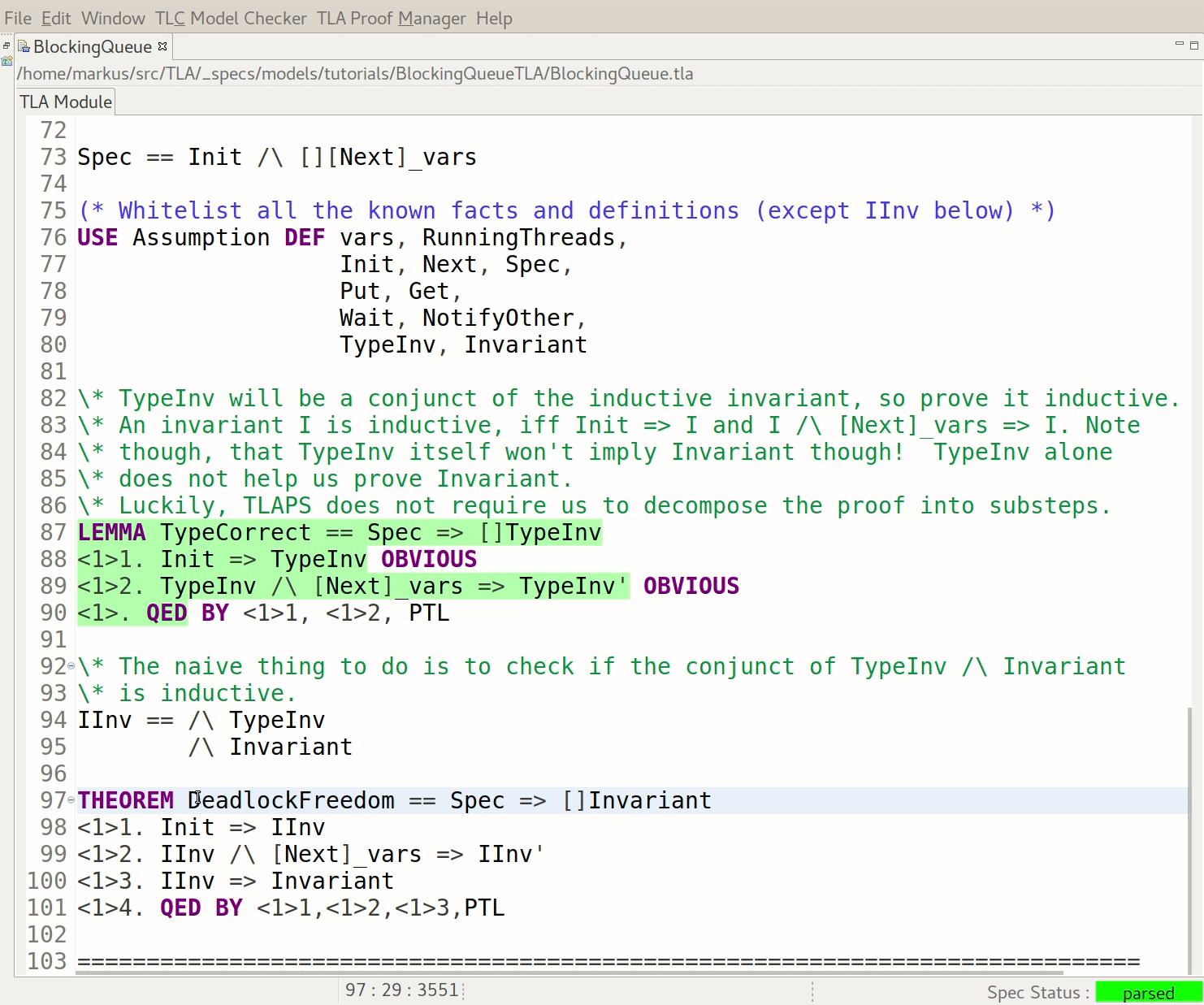
Invariant is not inductive, because Invariant /\ Next_vars => Invariant' does not
hold for e.g. the [buffer = <<>> /\ Wait(t)]_vars step (assum we are in the
(unreachable) state with RunnintThreads = {t}, the successor state will have
RunningThreads' = {} /\ waitSet' = (Producers \cup Consumers). A similar argument
applies to a [Len(buffer) = BufCapacity /\ Wait(t)]_vars step.
v14 (TLAPS): Proof that TypeInv is inductive.
Recall that the deadlock originally only happened iff
2*BufCapacity < Cardinality(Producers \cup Consumers). How do we know
that the solution with two mutexes hasn't a similar flaw, just for a different
inequation? All the model-checking in the world won't gives us absolute
confidence, because the domains for Producers, Consumers, and BufCapacity are
infinite. We have to prove that the solution with two mutexes is correct for all configurations no matter what values we chose for producer, consumer, or BufCapacity.
Here, we will use TLAPS to take the first step towards an invariance proof of deadlock freedom by proving that TypeInv is inductive. In the screencast below, TLAPS first checks the QED step,
then the 1<1> and 1<2> steps, and finally the top-level THEOREM.
Note that this step and the following ones require the TLA+ Toolbox and TLAPS! If you don't have the Toolbox or TLAPS, you can skip this part (TLAPS.tla has been added to this repository to avoid parser errors).
v13 (Bugfix): (Logically) two mutexes.
Remove notifyAll and instead introduce two mutexes (one for Producers and one for Consumers). A Consumer will notify the subset of Producers waiting on the Producer mutex (vice versa for a Producer).
The spec does not have to introduce two mutexes. Instead, we can just pick the right thread type from the set of waiting threads.
This fix completely solves the bug, but are we fully satisfied yet?
v12 (Bugfix): Always notify all waiting threads.
Always notify all waiting threads instead of a non-deterministically selected one. This fixes the deadlock bug but at a price: Load will spike when all (suspended) threads wake up at once.
As a bonus exercise, check if it necessary to notify all waiting threads in both Put and Get.
Note that this is the proposed solution to the bug in Challenge 14 of the c2 extreme programming wiki. To the best of my knowledge, not a single comment mentions that just one notifyAll suffices. Neither does anybody mention a more elegant fix that has no performance implications (see next step).
v11 (Bugfix): Non-deterministically notify waiting threads.
Non-deterministically notify waiting threads in an attempt to fix the deadlock situation. This attempt fails because we might end up waking the wrong thread up over and over again.
v10 (Animation): Add visualization of error-traces.
The trace with 2 procs, 1 cons, and a buffer of length 1 is minimal (length 8). The other trace shows how quickly the issue becomes a) incomprehensible and b) the length of the trace increases (46 states for 7 threads). TLC takes 75 secs on my machine to check this.
The animations are created in the Toolbox with:
- Check model BlockingQueue.cfg
- Set
Animationas the trace expression in the Error-Trace console - Hit Explore and export/copy the resulting trace to clipboard
- Paste into http://localhost:10996/files/animator.html
Without the Toolbox, something similar to this:
- Check model BlockingQueue.cfg with
java -jar tla2tools.jar -deadlock -generateSpecTE BlockingQueue('-generateSpecTE' causes TLC to generate SpecTE.tla/.cfg) - State trace expression
Animation(BlockingQueueAnim.tla)in SpecTE.tla - Download https://github.com/tlaplus/CommunityModules/releases/download/20200107.1/CommunityModules-202001070430.jar
- Check SpecTE with
java -jar tla2tools.jar:CommunityModules-202001070430.jar tlc2.TLC SpecTE - Copy trace into http://localhost:10996/files/animator.html (minor format changes needed)
v09 (Animation): Add prophecy variable to simplify animation.
The next-state relation has been restated to "predict" the value of t (threads) in the successor state. We will use the prophecy variable in the following commit to come up with an animation.
This and the following commit can be skipped unless you are interested in the more advanced concept of prophecy (http://lamport.azurewebsites.net/pubs/auxiliary.pdf) or animations (https://youtu.be/mLF220fPrP4).
v08 (continue): Infer inequation under which the system is deadlock free.
Based on the scaffolding in the two previous steps, we run TLC with the -continue option to not stop state space exploration after a violation of the invariant has been found. In other words, we ask TLC to find all violations, not just one of the shortest ones (Breadth-First search guarantees that TLC finds the shortest counterexample first).
java -jar /opt/TLA+Toolbox/tla2tools.jar -deadlock -continue BlockingQueue | grep InvVio | sort | uniq
<<"InvVio", 1, 3>>
<<"InvVio", 1, 4>>
<<"InvVio", 1, 5>>
<<"InvVio", 1, 6>>
<<"InvVio", 1, 7>>
<<"InvVio", 1, 8>>
<<"InvVio", 2, 5>>
<<"InvVio", 2, 6>>
<<"InvVio", 2, 7>>
<<"InvVio", 2, 8>>
<<"InvVio", 3, 7>>
<<"InvVio", 3, 8>>
A little bit of bashery trims TLC's output so that we - with some squinting - notice that BlockingQueue is deadlock free iff 2*BufCapacity >= Cardinality(Producers \cup Consumers). A simple R plot makes this even more visible ('d' indicates a configuration that deadlocks):
Collecting even more data, we can correlate the length of the error trace with the constants (Cardinality(Producers), Cardinality(Consumers), BufCapacity, and Cardinality(Producers \cup Consumers)):
v07 (continue): Declare Producers and Consumers to be symmetry sets.
The sets Producers and Consumers are symmetry sets for the BlockingQueue specification, meaning that permuting the elements in the sets does not change whether or not a behavior satisfies that behavior spec. TLC can take advantage of this to reduce the number of (distinct) states it has to examine from 57254 to 1647!
Note that TLC does not check if a set you declare to be a symmetry set really is one. If you declare a set to be a symmetry set and it isn't, then TLC can fail to find an error that it otherwise would find. An expression is symmetric for a set S if and only if interchanging any two values of S does not change the value of the expression. The expression {{v1, v2}, {v1, v3}, {v2, v3}} is symmetric for the set {v1, v2, v3} -- for example, interchanging v1 and v3 in this expression produces {{v3, v2}, {v3, v1}, {v2, v1}}, which is equal to the original expression. You should declare a set S of model values to be a symmetry set only if the specification and all properties you are checking are symmetric for S after the substitutions for constants and defined operators specified by the model are made. For example, you should not declare {v1, v2, v3} to be a symmetry set if the model substitutes v1 for some constant. The only TLA+ operator that can produce a non-symmetric expression when applied to a symmetric expression is CHOOSE. For example, the expression
CHOOSE x \in {v1, v2, v3} : TRUE
is not symmetric for {v1, v2, v3}.
Symmetry sets should not be used when checking liveness properties. Doing so can make TLC fail to find errors, or to report nonexistent errors. The Toolbox adds a warning to the model when you try this.
(The description of this step originates from https://tla.msr-inria.inria.fr/tlatoolbox/doc/model/model-values.html)
v06 (continue): Convert constants into variables.
In the section "Limitations of Model-Checking", Michel Charpentier points out that BlockingQueue is deadlock-free under some configurations, but that model checking is not helpful with finding the underlying mathematical function. This observation is true in general because we cannot ask TLC to compute the set of all configurations for which BlockingQueue is deadlock-free, but at least we can ask it to find as many data points as possible. From those data points, we can try to infer/learn the function.
In this step, we rewrite BlockingQueue to check multiple configurations instead of a single one (p1c2b1) at once. Note that the rewrite increases the complete state space to 57254 distinct states, but TLC continues to find the behavior shown in the previous step. This is because TLC - by default - explores the state space with breadth-first search. This search mode guarantees to always find the shortest counterexample (if TLC runs -workers N with N > 1, it only returns the shortest counterexample with high probability).
We hope to better support checking different constant values in the future.
v05: Add Invariant to detect deadlocks.
Add Invariant to detect deadlocks (and TypeInv). TLC now finds the deadlock for configuration p1c2b1 (see below) as well as the one matching the Java app p4c3b3.
Error: Invariant Invariant is violated.
Error: The behavior up to this point is:
State 1: <Initial predicate>
/\ buffer = <<>>
/\ waitSet = {}
State 2: <Next line 52, col 9 to line 55, col 45 of module BlockingQueue>
/\ buffer = <<>>
/\ waitSet = {c1}
State 3: <Next line 52, col 9 to line 55, col 45 of module BlockingQueue>
/\ buffer = <<>>
/\ waitSet = {c1, c2}
State 4: <Next line 52, col 9 to line 55, col 45 of module BlockingQueue>
/\ buffer = <<p1>>
/\ waitSet = {c2}
State 5: <Next line 52, col 9 to line 55, col 45 of module BlockingQueue>
/\ buffer = <<p1>>
/\ waitSet = {p1, c2}
State 6: <Next line 52, col 9 to line 55, col 45 of module BlockingQueue>
/\ buffer = <<>>
/\ waitSet = {p1}
State 7: <Next line 52, col 9 to line 55, col 45 of module BlockingQueue>
/\ buffer = <<>>
/\ waitSet = {p1, c1}
State 8: <Next line 52, col 9 to line 55, col 45 of module BlockingQueue>
/\ buffer = <<>>
/\ waitSet = {p1, c1, c2}
Note that the Java app with p2c1b1 usually deadlocks only after it produced thousands of lines of log statements, which is considerably longer than the error trace above. This makes it more difficult to understand the root cause of the deadlock. For config p4c3b3, the C program has a high chance to deadlock after a few minutes and a couple million cycles of the consumer loop.
Sidenote: Compare the complexity of the behavior described in Challenge 14 of the c2 extreme programming wiki for configuration p2c2b1 with the TLA+ behavior below. The explanation in the wiki requires 15 steps, whereas - for p2c2b1 - TLC already finds a deadlock after 9 states (and two more after 11 states).
Invariant Invariant is violated.
The behavior up to this point is:
1: <Initial predicate>
/\ buffer = <<>>
/\ waitSet = {}
2: <Next line 53, col 9 to line 56, col 45 of module BlockingQueue>
/\ buffer = <<>>
/\ waitSet = {c2}
3: <Next line 53, col 9 to line 56, col 45 of module BlockingQueue>
/\ buffer = <<>>
/\ waitSet = {c1, c2}
4: <Next line 53, col 9 to line 56, col 45 of module BlockingQueue>
/\ buffer = <<p1>>
/\ waitSet = {c2}
5: <Next line 53, col 9 to line 56, col 45 of module BlockingQueue>
/\ buffer = <<p1>>
/\ waitSet = {p1, c2}
6: <Next line 53, col 9 to line 56, col 45 of module BlockingQueue>
/\ buffer = <<p1>>
/\ waitSet = {p1, p2, c2}
7: <Next line 53, col 9 to line 56, col 45 of module BlockingQueue>
/\ buffer = <<>>
/\ waitSet = {p1, p2}
8: <Next line 53, col 9 to line 56, col 45 of module BlockingQueue>
/\ buffer = <<>>
/\ waitSet = {p1, p2, c1}
9: <Next line 53, col 9 to line 56, col 45 of module BlockingQueue>
/\ buffer = <<>>
/\ waitSet = {p1, p2, c1, c2}
v04: Debug state graph for configuration p2c1b1.
In the previous step, we looked at the graphical representation of the state graph. With the help of TLCExt!PickSuccessor we build us a debugger with which we study the state graph interactively. We learn that with configuration p2c1b1 there are two deadlock states:
The CommunityModules release has to be added to TLC's command-line:
java -cp tla2tools.jar:CommunityModules.jar tlc2.TLC -deadlock BlockingQueue
Note that TLC's -continue flag would have also worked to find both
deadlock states.
v03: State graph for configurations p1c2b1 and p2c1b1.
Slightly larger configuration with which we can visually spot the
deadlock: .
BlockingQueueDebug.tla/.cfg shows how to interactively explore a state graph for configuration p2c1b1 with TLC in combination with GraphViz (xdot):
java -jar tla2tools.jar -deadlock -dump dot,snapshot p2c1b1.dot BlockingQueueDebug
v02: State graph for minimum configuration p1c1b1.
Initial TLA+ spec that models the existing (Java) code with all its bugs and shortcomings.
The model uses the minimal parameters (1 producer, 1 consumer, and
a buffer of size one) possible. When TLC generates the state graph with
java -jar tla2tools.jar -deadlock -dump dot p1c1b1.dot BlockingQueue,
we can visually verify that no deadlock is possible with this
configuration: .
v01: Java and C implementations with configuration p4c3b3.
Legacy Java code with all its bugs and shortcomings. At this point in the tutorial, we only know that the code can exhibit a deadlock, but we don't know why.
What we will do is play a game with the universe (non-determinism).
Launch the Java app with java -cp impl/src/ org.kuppe.App in
the background and follow along with the tutorial. If the Java app
deadlocks before you finish the tutorial, the universe wins.
(For the c-affine among us, impl/producer_consumer.c is a C implementation of the blocking buffer sans most of the logging).
v00: IDE setup, nothing to see here.
Add IDE setup for VSCode online and gitpod.io.



